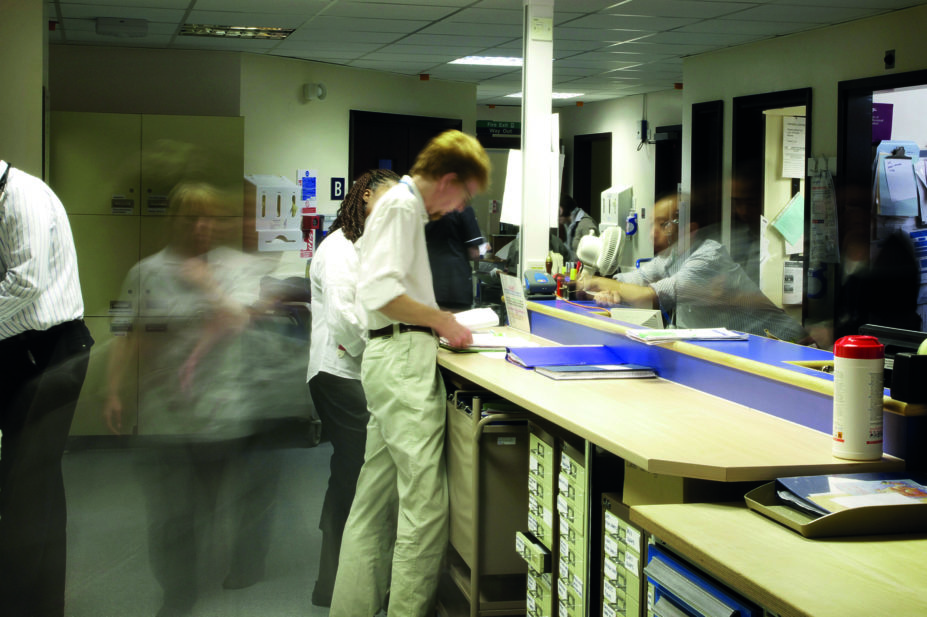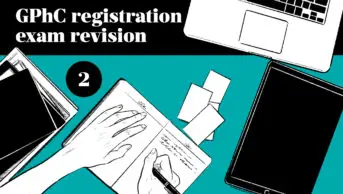
Alamy Stock Photo
Sustainability and transformation plans (STPs) are the blueprints for the future of the NHS, setting out how 44 areas across England — identified as geographical STP ‘footprints’ — plan to get the best health outcomes for their populations from increasingly stretched financial resources.
The plans — which support the delivery of the ‘Five year forward view’, published in October 2014[1]
— were announced in NHS planning guidance in December 2015 to ensure health and care services are built around the needs of local populations[2]
.
Many of the solutions to the problems the NHS faces have a link to pharmacy — from the need for greater efficiency in hospitals through to keeping older people at home or in residential care rather than in hospital.
STPs are being drawn up by groups of local NHS organisations and local authorities, with a lead who is generally the chief executive of a NHS trust or an accountable officer from a clinical commissioning group. Pharmacists should be able to bring their knowledge and skills to the table to help develop deliverable solutions which have the buy-in of healthcare professionals.
But these groups have widely criticised the low level of engagement by pharmacists.
Pharmacist engagement
Robbie Turner, director for England at the Royal Pharmaceutical Society, the professional leadership body for pharmacists in Great Britain, argues that engagement with pharmacists has been “variable and, in the main, disappointing”.

Source: MAG / The Pharmaceutical Journal
Robbie Turner, director for England at the Royal Pharmaceutical Society, the professional leadership body for pharmacists in Great Britain, argues that engagement with pharmacists has been ‘variable and, in the main, disappointing’.
“What we have heard from our members is that STPs have been drawn up by the same people who have been engaged in system design for the last ten years,” he says.
Not involving pharmacy in the creation and implementation of STPs has risks that may pose missed opportunities for transformational change, Turner adds. NHS system leaders, who create the plans, need to recognise the role of pharmacists, not just in terms of delivery of services to patients, but in the design and decision-making around how the NHS will meet the challenges of the future, he says.
If you are not at the right table, you don’t know what is going on
Rahul Singal, pharmacy and medicines lead for the South East London STP, points out that much of what is happening in STPs is at high level and therefore hard to translate to the working lives of pharmacists, both in community and in hospitals. Eventually, of course, these changes will have profound effects on many people working in healthcare, but Singal argues that it may take something that directly affects pharmacists to bring it home to them.

Source: Courtesy of Rahul Singal
Rahul Singal, pharmacy and medicines lead for the South East London STP, points out that much of what is happening in STPs is at high level and therefore hard to translate to the working lives of pharmacists
David Campbell, chief pharmacist at Northumbria Healthcare Foundation Trust, warns against unrealistic expectations of how much pharmacy will be name-checked in high-level STP documents. There is a need to interpret where pharmacy fits into the ‘big picture’, he says.
Campbell’s area is developing a more integrated pharmacy service that spreads from hospital through to community hubs from which pharmacists can provide services to people identified through a risk stratification service. The benefits of this more integrated service include patient discharge not being delayed by minor problems with medications, because the community-based team can deal with them.
Direct mention of pharmacy or pharmacists in many of the 44 STPs tends to be limited. Kent and Medway’s STP has just two, for example
[3]
. One on developing workforce — specifically in community and primary pharmacy — and one on the role of community pharmacists in the future model of care.
Arguably, local pharmacy networks (LPNs), which provide clinical input into NHS England’s local area teams and support implementation of policy, could play a greater role.
Martin Stephens, chair of the Wessex LPN, says they have not generally been “front and centre”, although there are examples where this is not the case. For example, he says, Hampshire and Isle of Wight Local Pharmaceutical Committee (LPC) set up a meeting to look at community pharmacy’s role in the local STP and key leaders from the STP joined the discussions.
The ‘top table’ of most STPs will involve chief executives from the participating organisations and generally there are few pharmacists. Further down in the structure of STPs, where there are usually a number of boards looking at particular themes or programmes of work, pharmacists may be more evident. In South East London, for example, several pharmacists sit on its STP project boards. As a result, personal relationships between pharmacy leaders and those at the top of STPs or with the ability to influence them are important.
Liz Stafford, communications and engagement lead for Community Pharmacy Lancashire, which represents community pharmacy contractors in Lancashire, says: “We have nurtured some key relationships with directors of public health and GPs.”

Source: Courtesy of Liz Stafford
Liz Stafford, communications and engagement lead for Community Pharmacy Lancashire, which represents community pharmacy contractors in Lancashire, says: ‘We have nurtured some key relationships with directors of public health and GPs’.
The same is true in Northumbria, where existing relationships and local vanguard schemes have helped advance pharmacy’s case within the STP.
Hospital/community split
Many STPs are splitting their activities into different work streams: pharmacy often sits across several while community and hospital pharmacy may be separated. Hospital pharmacy can be seen as a clinical support service — which rather ignores the autonomy of pharmacists — or as part of a procurement stream. Some areas have a separate medicines stream that often recognises pharmacy’s value in providing clinical care and improving outcomes for patients.
There is a bit of a hospital/primary care split at the moment, which is probably unhelpful
“If you are not at the right table, you don’t know what is going on,” says Roger Fernandes, chief pharmacist at King’s College Hospital Foundation Trust.

Source: Courtesy of Roger Fernandes
Roger Fernandes, chief pharmacist at King’s College Hospital Foundation Trust has heard from colleagues elsewhere that pharmacy is struggling to have its voice heard.
While Fernandes’ STP footprint area in South East London has pharmacists actively involved, he has heard from colleagues elsewhere that pharmacy is struggling to have its voice heard.
Singal agrees that there can be division between how hospital pharmacy is treated compared with community and primary care pharmacy. He is currently working within the provider productivity work stream looking at making the efficiencies in hospitals that were outlined in the Carter review
[4]
. But community pharmacy and primary care come under other areas, he says, suggesting that perhaps a more joined-up approach is required.
“There is a bit of a hospital/primary care split at the moment, which is probably unhelpful,” he adds.
Fernandes points out that when the South East England STP looked at out-of-hours medicines optimisation, this brought hospital pharmacists more into contact with their community-based colleagues.
Hospital-based pharmacy has an obvious structure, allowing a chief pharmacist or deputy chief pharmacist to be invited onto STP project boards. In South East London, there was already close working between the chief pharmacists of trusts in the area. “We have a good history of collaboration and this was our starting point,” Fernandes says.
But no such structure exists for community pharmacy, except through local pharmacy committees (LPCs) as broad representative bodies with powers to ‘force’ their local members to do anything.
Where are the opportunities?
There are a number of common themes in all 44 STP documents that could directly impact pharmacy:
- Hospitals will be under pressure to reduce costs through streamlined processes and greater joint working across hospitals. In pharmacy terms, this could lead to more centralised units for some specialist services, such as aseptic units. These changes are very much in line with those proposed as a result of the Carter review but the focus of STPs on reducing costs across wider areas will give them greater impetus.
- Some STPs are looking to scale up initiatives pioneered in vanguards, such as greater involvement of pharmacists in care homes to prevent admissions. In some areas, there has been movement towards accountable care organisations, where a single NHS organisation takes on a budget and provides services for all parts of the patient’s pathway. Pharmacy could have a role to play in this.
- STP teams are keen to reduce the number of people taking up expensive hospital beds, and plan to do this through early interventions in the community to keep people out of hospital and providing care at home for less serious cases. Facilitating supported early discharge could be another area where pharmacy input is vital.
- Relieving the pressure on other healthcare professionals by diverting appropriate patients to services delivered by pharmacy staff. This could impact on community pharmacists – who might take on additional services that keep people out of GP services – but there could also be opportunities to have more pharmacists working in A&E departments, as the Royal Pharmaceutical Society has proposed.
Pharmacists — especially those seeking new opportunities because they are facing cuts to their income — would welcome many of these changes and recognise they could both develop the pharmacy ‘offering’ and start to make more of a difference to patients’ health and well-being.
There is an opportunity to explore innovative ways in which community pharmacies can engage
While some of these changes will take three to five years to bring about, some STPs have pledged to start rolling out existing projects across a wider area. In Lancashire, for example, £250,000 has been pledged to roll out ‘Healthy Living Pharmacies’ to a level two standard of the health living pharmacies framework
[5]
. This funding came through the local branch of Health Education England, the executive non-departmental public body of the Department of Health.
In the same STP area in Lancashire, Pharmacy Plus clinics offering minor illness treatment through pharmacies are also set to spread across the patch: it started in a vanguard area.
In South East London, one of the earliest effects of the STP for pharmacists will be the introduction of a rotation for newly qualified pharmacists. From September 2017, they will be offered the chance to move between hospitals, community pharmacies and in GP surgeries. Other changes could take longer. Some services, not yet specified, may be provided across the hospitals in the STP rather than provided at each individual one , which could demand more flexible working from pharmacists, and shared ‘back office’ services.
Often these projects are underpinned by better IT, allowing pharmacies access to electronic patient records, and are roll-outs of existing services that have been limited in geographical scope, rather than entirely new services. However, despite the financial state of the NHS, money is being found.
“There is an opportunity to explore innovative ways in which community pharmacies can engage so that if new tenders go out, prime providers can subcontract to them to deliver a raft of new services,” Stafford says.
What are the challenges?
Once pharmacy is involved in STPs, it can be a challenge for those at the centre to find the time to be fully involved.
Singal says the South East London STP has “a dedicated resource” around pharmacy.
“We are recruiting three other project managers,” he explains. “We are putting resources in to do it properly. And we are well embedded in the governance process. We are not on the sidelines.”
However, LPCs – which are already small – may face challenges in attending all STP meetings and taking on some of the work in developing proposals. Singal cautions that active involvement in STPs requires “time and headspace” and is difficult to do as well as the day job. He also warns that it may be necessary for pharmacists to take on some additional work without pay initially and wait for commissioning to come through.
The people behind STPs also need to take advantage of what has already been tried successfully. The 44 STP areas need to learn from each other, too, so they don’t become bigger silos. There are example of changes involving pharmacists across all STP areas that could be adopted and make a difference quickly.
Turner also points to where pharmacists have been involved in care home vanguards, carrying out work such as medication reviews. This type of intervention resulted in reduced costs to the NHS as well as reduced health risks for care home residents. These approaches could be adopted quickly elsewhere and bring almost immediate benefits.
However, he adds: “STPs risk the same fate that other organisational changes have had in the NHS, which is trying to reinvent things and not learning from some of the examples and evaluations because pharmacy has not been brought into the decision making at an early stage.”
“But,” he concludes, “it is not too late.”
Getting pharmacy’s voice heard
There are still plenty of opportunities for pharmacists to influence how decisions are implemented in sustainability and transformation plans (STPs) and focus on areas where they can really make a difference. The message from many people is “don’t wait to be asked”.
Martin Stephens, chair of the pharmacy Local Professional Network in Wessex, says: “STPs are the only game in town, so pharmacy’s contribution to their success for the population and sustainability of services is vital.”.
Pharmacists may need to be proactive to spot the opportunities (or gaps) in their local STP and bang the drum about what pharmacists have to offer. The Royal Pharmaceutical Society (RPS) recently wrote to all STPs about what pharmacy can do, highlighting areas such as A&E department and general practice.
Robbie Turner, director for England at the RPS, says: “There is a real opportunity for [RPS members] to engage with the work that STPs are doing.” He adds that the RPS would like to hear from pharmacists who are involved so it can support them in their work.
Changes need not be massive, he says, as the incremental effect of small changes can still make a huge difference both to patients and to the NHS.
Stephens urges pharmacists to “tell a story” to get their issues on STPs’ agendas.
“If you can find something that is really working locally, that makes a difference and get that onto the table of a key influencer,” he says.
“Find out who the movers and shakers are and get an anecdote about something successful into their hands – tell a story about what difference it makes and what problems it solves,” he adds. While the evidence base is important, sometimes anecdotes help get the message across.
Liz Stafford, communications and engagement lead for Community Pharmacy Lancashire, adds that pharmacy needs to present its message in the context of the Five Year Forward View and how it can contribute to achieving its objectives and those mentioned in the local STP.
Leading the way: Manchester
One of the sustainability and transformation plans (STP) areas where pharmacy seems embedded in the process is Greater Manchester, where health and social is already substantially devolved.
Adam Irvine, chief executive at the Greater Manchester local pharmacy committee (LPC), says pharmacy has been increasingly involved with the STP’s plans and worked closely with leading figures at the Greater Manchester Health and Social Care Partnership, a body made up of the NHS organisations and councils in the region that is overseeing health and social care.

Source: Manchester LPC
Adam Irvine, chief executive at the Greater Manchester local pharmacy committee, says pharmacy has been increasingly involved with the STP’s plans and worked closely with the Greater Manchester Health and Social Care Partnership.
“We have really strong governance within the strategic partnership board in which all of the primary care providers are involved,” he says. There is also a pharmacy advisory board.
Projects include looking at how pharmacy can have a consistent offering on additional services across all ten boroughs in Greater Manchester. This will involve a framework of services with pharmacists offering different steps on a tier that can be commissioned in each area, according to local needs.
This offers clarity around what will be delivered at each tier on the framework and what fees it will attract, Irvine says. “It gives commissioners the agility to respond to what is needed in their local areas.
“We want to give them a consistency of offering,” he adds.
Pharmacists working in GP surgeries can sometimes feel distant from community pharmacists — even though their patients overlap — but greater joint working is developing in Manchester with referrals between the two. Hospital-based pharmacists are also joining in discussions about seamless care and medicines optimisation, as well as information transfer when a patient leaves hospital so that both their surgery and their local community pharmacy are aware of what has happened to them in hospital. Information technology will be vital in this and other projects.
“When I speak to colleagues around the country they are quite envious of how we got there but you can’t overestimate the work we have put in,” Irvine says.
There will also be challenges around scaling up work and implementation times — although he is hopeful some changes can be effected quickly. “It is not like we have had to kick doors down to make it happen.”
Ultimately, Irvine is optimistic that pharmacy will play an important role in the local STP. It chimes in with the zeitgeist of moving the point of care closer to the patient.
“Pharmacy is ideally placed for that,” he says. “But it is not going to be instant results because we are talking about transforming healthcare.”
References
[1] NHS England. Five year forward view. Available at: https://www.england.nhs.uk/wp-content/uploads/2014/10/5yfv-web.pdf (accessed May 2017)
[2] NHS England. ‘Five year forward view’ planning guidance. Available at: https://www.england.nhs.uk/wp-content/uploads/2015/12/planning-guid-16-17-20-21.pdf (accessed May 2017)
[3] Kent and Medway NHS. Transforming Health and Social Care. The Sustainability and Tranformation Plan. Available at: http://kentandmedway.nhs.uk/stp/stp/ (accessed May 2017)
[4] Department of Health. Operational productivity and performance in English NHS acute hospitals: unwarranted variations. Available at: https://www.gov.uk/government/uploads/system/uploads/attachment_data/file/499229/Operational_productivity_A.pdf (accessed May 2017)
[5] Pharmaceutical Services Negotiating Committee. Healthy Living Pharmacies. Available at: http://psnc.org.uk/services-commissioning/locally-commissioned-services/healthy-living-pharmacies/ (accessed May 2017)


